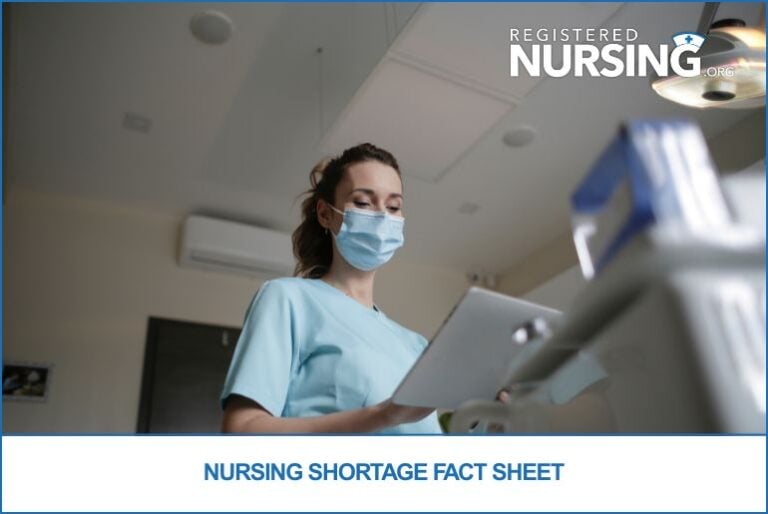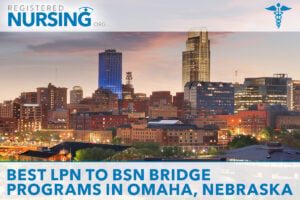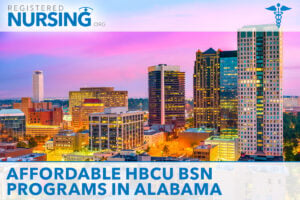Nursing Shortage Fact Sheet: What To Know for 2025

The United States is facing a critical and persistent shortage of registered nurses—a growing concern that significantly impacts patient care, public health outcomes, healthcare delivery, and the nursing profession at large. According to the U.S. Bureau of Labor Statistics (BLS), more than 193,000 openings for registered nurses are projected each year through 2032, due to both workforce turnover and an increasing demand for healthcare services in aging populations. This sustained shortfall affects hospitals, long-term care facilities, outpatient clinics, schools, and community health organizations.
The nursing shortage is not just about numbers; it’s about the stress it places on the current workforce, the challenges it poses to nursing education programs, and the barriers it creates for equitable healthcare access. Whether you’re a student preparing to enter nursing school or an experienced RN exploring career transitions, understanding the full scope of the shortage—along with its causes and potential solutions—can empower you to make strategic, informed decisions.
This comprehensive fact sheet delivers a data-backed overview of the nursing shortage in 2025. It is designed to equip readers with the insight needed to plan their career paths, advocate for systemic improvements, and contribute meaningfully to the future of nursing.
Key Statistics: The Scope of the Nursing Shortage
Before we explore the root causes and potential solutions, it's important to grasp the scale of the current shortage. These figures highlight the urgent need for more nursing professionals across the country.
Why Is There a Nursing Shortage?
The nursing shortage is driven by a combination of demographic shifts, workforce challenges, educational barriers, and systemic pressures. Recognizing the layers behind this crisis is the first step toward lasting solutions.
Aging Workforce
Nearly half of the current nursing workforce is over the age of 50 (NCSBN). As these experienced professionals approach retirement, healthcare facilities face a wave of vacancies that are difficult to fill, especially in rural and underserved areas.
Increased Demand for Care
The U.S. population is aging, and with that comes a rising demand for chronic disease management, home healthcare, and long-term care services. HRSA projects a shortfall of over 500,000 registered nurses by 2030 due to this increased demand.
Bottlenecks in Nursing Education
Despite high interest in nursing careers, schools are unable to accept all qualified applicants. According to the American Association of Colleges of Nursing (AACN), over 91,000 qualified applicants were turned away from nursing programs in 2021 due to lack of faculty, classroom space, and clinical placement opportunities. But nursing bridge programs are helping to expand education access.
Burnout and Attrition
Workplace stress, understaffing, and emotional exhaustion have led many nurses to leave the profession. The COVID-19 pandemic accelerated this trend, but burnout continues to be a significant factor in ongoing workforce attrition.
Where the Shortage Hits Hardest
While all healthcare settings are affected by the nursing shortage, certain regions and specialties face more acute challenges. Understanding these hotspots can help nurses align their career paths with areas of greatest need and opportunity.
Geographic Disparities
Some states are experiencing more severe shortages than others. The following table shows states projected to face the most critical RN deficits by 2030:
| State | Projected Shortage |
| California | 44,500+ |
| Texas | 15,900+ |
| New Jersey | 11,400+ |
| South Carolina | 10,400+ |
| Alaska | 5,400+ [HRSA] |
Read more about the States with the Largest Nursing Shortages.
Specialty Areas in Need
Certain nursing specialties are especially impacted:
- Geriatric Nursing: Aging population = higher demand.
- Public Health Nursing: Essential for addressing community health disparities.
- Mental Health Nursing: Rising need post-pandemic.
- Rural Health Nursing: Limited workforce availability in remote areas.
What This Means for Aspiring and Current Nurses
Although the nursing shortage poses challenges, it also creates opportunity. Nurses today are in high demand, and many are using this moment to negotiate better working conditions, pursue advanced roles, or shape healthcare policy.
Competitive Salaries and Benefits
Hospitals and health systems are offering increased wages, bonuses, and loan repayment incentives to attract and retain nurses. Some states also offer state-funded tuition reimbursement for RNs who commit to working in shortage areas. You can review state-by-state nursing salaries to help inform your job search.
Expanded Career Pathways
The demand for nurses extends beyond bedside roles. Options include:
- Nurse educators (help address faculty shortages).
- Nurse practitioners (fill provider gaps in primary care).
- Telehealth and informatics (growing post-COVID fields).
These alternative roles offer not only job stability but also the opportunity to influence healthcare delivery from leadership, education, and tech-driven angles.
Real-World Example: New Mexico's “Grow Your Own Nurse” Initiative
To combat rural shortages, New Mexico launched a program that supports local students through nursing school in exchange for service commitments in their home communities. This helps retain talent in underserved regions and builds long-term workforce stability. It also demonstrates the power of community-based education initiatives to strengthen regional healthcare systems.
What Can Be Done to Fix the Shortage?
Solving the nursing shortage requires collaboration across education, government, and the healthcare sector. Several strategies are being employed nationwide.
Strengthening Nursing Education
- Increase funding for nursing schools to hire faculty
- Expand clinical training sites through hospital partnerships
- Streamline pathways for RN to BSN and LPN to RN advancement.
Improving Workplace Conditions
- Enforce safe staffing ratios
- Offer mental health and peer support for nurses
- Provide leadership development and flexible scheduling
Leveraging Policy and Technology
- Advocate for state and federal workforce funding
- Use telehealth and AI to extend reach without overburdening staff
- Modernize licensure portability to move across states more easily.
Moving Forward: Empowered, Informed, and Ready
The nursing shortage is a complex challenge, but it also represents a transformative moment for the profession. With better support, smarter policies, and intentional investment in education and well-being, nurses can lead the way in creating a stronger healthcare system.
Whether you're considering nursing school, returning after a break, or looking to advance your practice, there has never been a more important time to engage in the profession. Equipped with the facts, you can be part of the solution. Browse nursing programs near you to get started.
Sources
- U.S. Bureau of Labor Statistics
- Health Resources and Services Administration (HRSA)
- American Association of Colleges of Nursing (AACN)
- National Council of State Boards of Nursing (NCSBN)
Latest Articles & Guides
One of the keys to success as a registered nurse is embracing lifelong learning. Our articles and guides address hot topics and current events in nursing, from education to career mobility and beyond. No matter where you are on your nursing journey, there’s an article to help you build your knowledge base.
Browse our latest articles, curated specifically for modern nurses.



